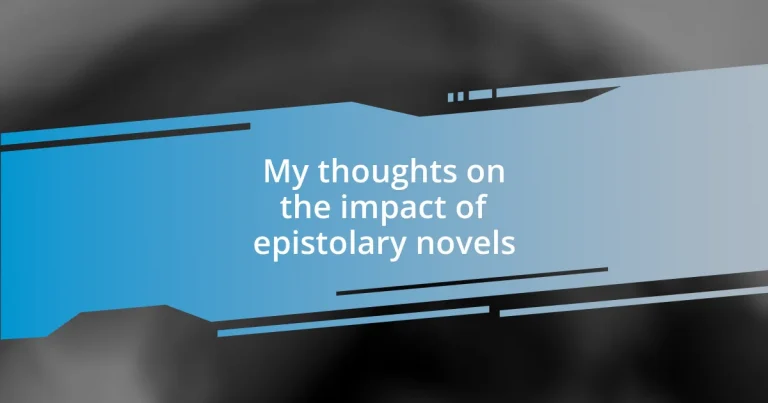Key takeaways:
- Epistolary novels create deep emotional connections between readers and characters by exposing intimate thoughts and experiences through letters and diary entries.
- These novels serve as important historical documents, reflecting societal issues, personal struggles, and the evolution of character identities, while allowing readers to engage with complex themes of identity and relationships.
- Modern adaptations of epistolary formats, such as social media and graphic novels, innovate storytelling methods, making classic narratives relevant and engaging for contemporary audiences.
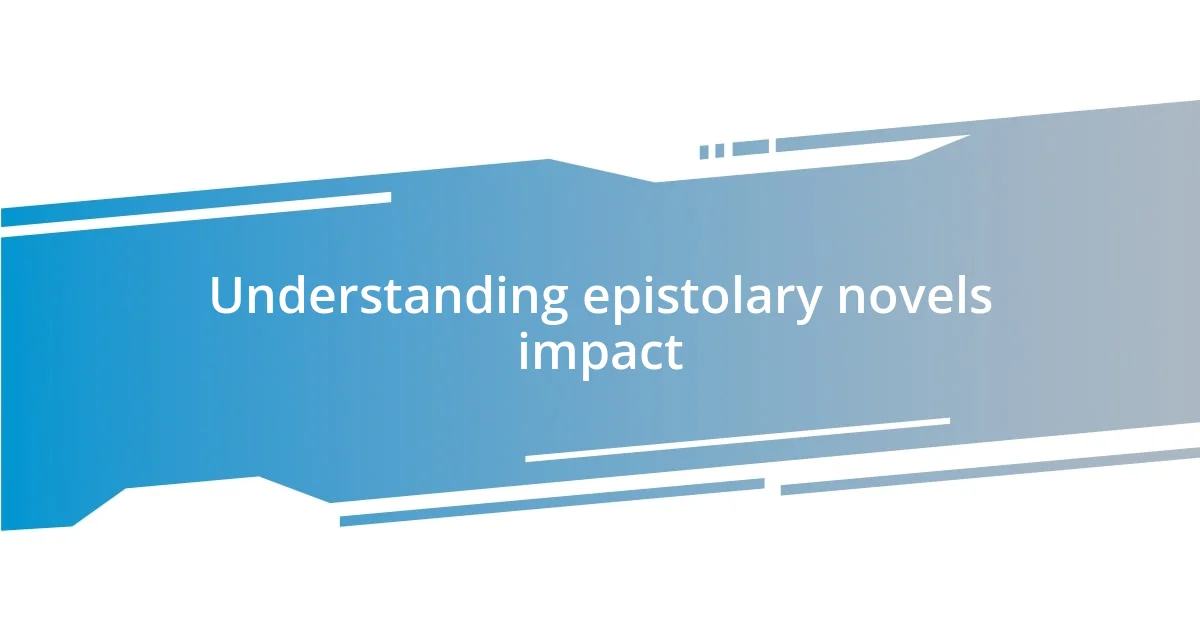
Understanding epistolary novels impact
Epistolary novels have a unique ability to draw readers into the intimate thoughts and emotions of characters through their letters or diary entries. I remember reading “The Perks of Being a Wallflower,” and how it felt as if I was holding the protagonist’s hand, experiencing his loneliness and joys. Doesn’t that make you wonder how deeply letters can connect us to a character’s world?
The impact of these novels goes beyond storytelling; they challenge readers to consider different perspectives. For instance, in reading classics like “Dracula,” I was struck by how each letter revealed a different facet of fear and desire, showcasing the complexity of human emotions. When characters express themselves so rawly, doesn’t it compel us to reflect on our own feelings in a more profound manner?
Moreover, the structure of epistolary novels fosters a sense of immediacy and urgency. When I found myself reading “The Color Purple,” the letters felt like lifelines, immersing me in urgent, sometimes painful experiences. How much more relatable are the struggles and triumphs when they are laid bare in personal correspondence? This format has a way of making me question, what would I write to someone if I had to articulate my innermost thoughts?
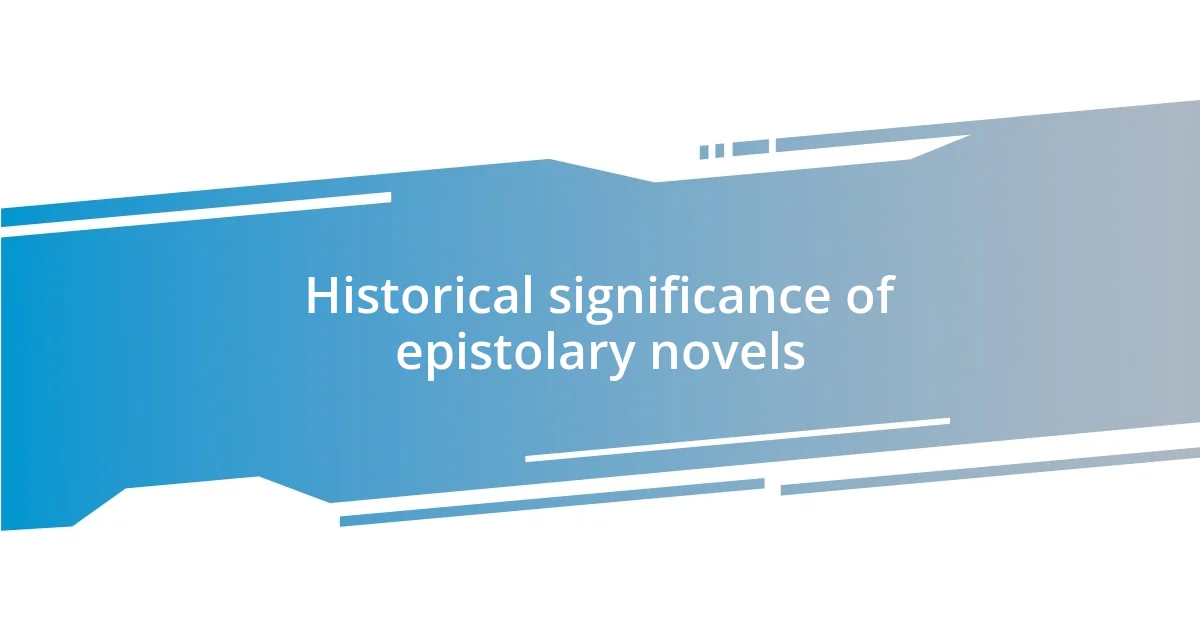
Historical significance of epistolary novels
Epistolary novels hold a prominent place in literary history, serving not only as a captivating storytelling format but also as a means of social commentary. I still recall flipping through “The Sorrows of Young Werther” and realizing how it reflected the Romantic ideals of its time. The letters felt like a window into the emotional turmoil of a generation, demonstrating literature’s power to capture collective sentiments.
- They offered a voice to marginalized perspectives, such as women and the working class.
- They were pivotal in shaping the modern novel, emphasizing character development and personal conflict.
- They sparked conversations about privacy and surveillance, evident in works like “Frankenstein.”
- They served as a bridge for political discourse, often highlighting societal issues and influencing public opinion.
The inclusion of personal letters has allowed readers to see the raw and often unfiltered emotions behind significant historical events. For instance, encountering the letters of soldiers during wartime deepened my understanding of courage and despair, reinforcing the notion that literature can be a powerful vehicle for empathy and connection. Each letter or diary entry stands as a testament to the human experience, making the historical significance of these novels impossible to overlook.
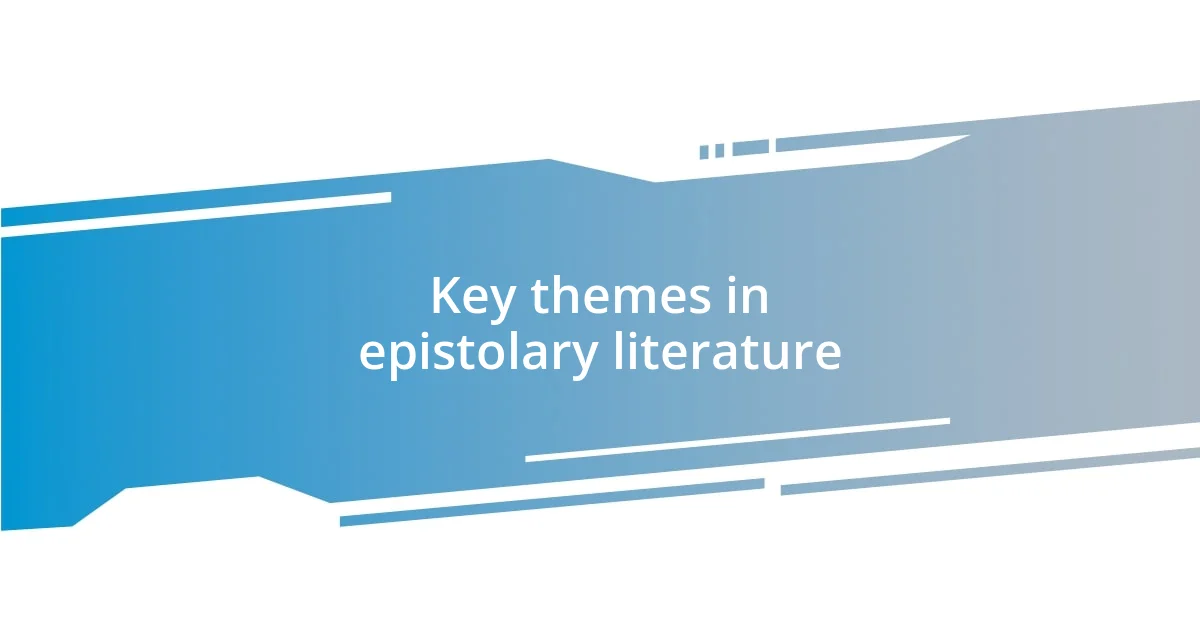
Key themes in epistolary literature
Epistolary literature often navigates complex themes of identity and self-discovery. I remember when I read “Dear Evan Hansen,” the letters presented a candid exploration of yearning and belonging, making me reflect on my own identity struggles. How often do we write to understand ourselves better, expressing thoughts we might not dare to voice in conversation? It emphasizes that our written words can serve as mirrors, revealing layers of our inner selves in ways we might not expect.
Another prominent theme is the exploration of relationships, both platonic and romantic. The correspondence in “84, Charing Cross Road” illustrated the deep connection between the characters despite the physical distance. I felt such warmth in their exchanges that it made me reevaluate my own friendships—how do we foster intimacy through words in an increasingly digital world? In those letters, I found echoes of my personal experiences, proving that relationships, molded by distance and communication, can transcend time and space.
Lastly, the theme of time is intricately woven into epistolary narratives. I recall reading “The Diary of a Young Girl” and being struck by Anne Frank’s ability to encapsulate her youth and fears amidst harrowing circumstances. The diary entries felt like snapshots, capturing fleeting moments that shaped her story. Isn’t it fascinating how written words can preserve our thoughts for future generations, allowing them to glimpse into our minds? It underscores the idea that through letters, we capture not just events but the emotions tied to those moments, creating a rich tapestry of life experiences.
| Theme | Description |
|---|---|
| Identity and Self-Discovery | Explores how characters reveal their identities and self-reflections through personal letters. |
| Relationships | Examines the connections between characters, highlighting intimacy and distance through written correspondence. |
| Time | Captures the passage of time and the emotions linked to specific moments in the characters’ lives. |
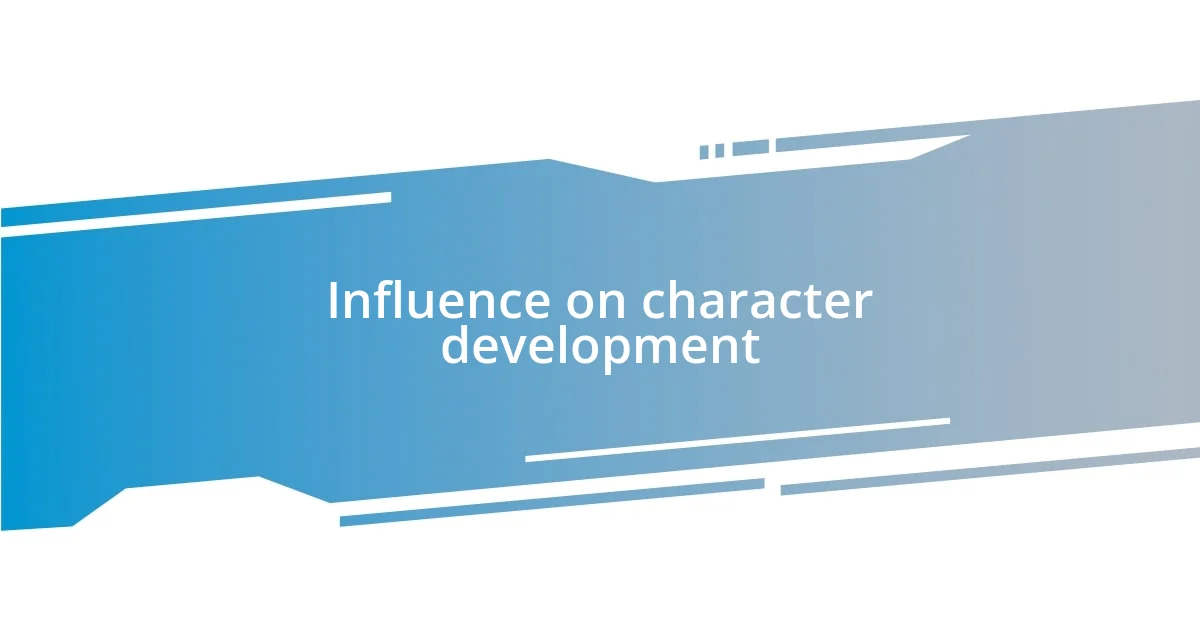
Influence on character development
The unique format of epistolary novels provides an intimate glimpse into characters’ inner worlds, shaping their development in profound ways. For instance, while reading “The Color Purple,” I found myself deeply invested in Celie’s letters. They reveal her evolution from a voiceless girl to a confident woman, illustrating how writing serves as a catalyst for her self-assertion. Isn’t it remarkable how the act of writing can empower characters to find their voices?
Moreover, epistolary novels often unravel character relationships through their correspondence, highlighting not only what is said but also what is left unsaid. In “The Perks of Being a Wallflower,” the protagonist Charlie’s letters allow readers to see his vulnerabilities and connections with others. I often ponder how characters’ true feelings can be uncovered in the pauses and silences of their written exchanges. This layered communication makes their experiences relatable, drawing me further into their emotional journeys.
Finally, the letters often serve as a narrative tool that allows characters to confront their pasts and redefine their futures. I remember being particularly moved by the way Esther Greenwood narrates her descent into mental illness in “The Bell Jar.” Her letters paint a vivid picture of her struggles, strengthening my understanding of the complex intersections between identity and mental health. How do these written reflections lead characters to greater self-awareness? Through their letters, they unearth truths that are often obscured in more traditional storytelling forms, making their transformations feel authentic and earned.
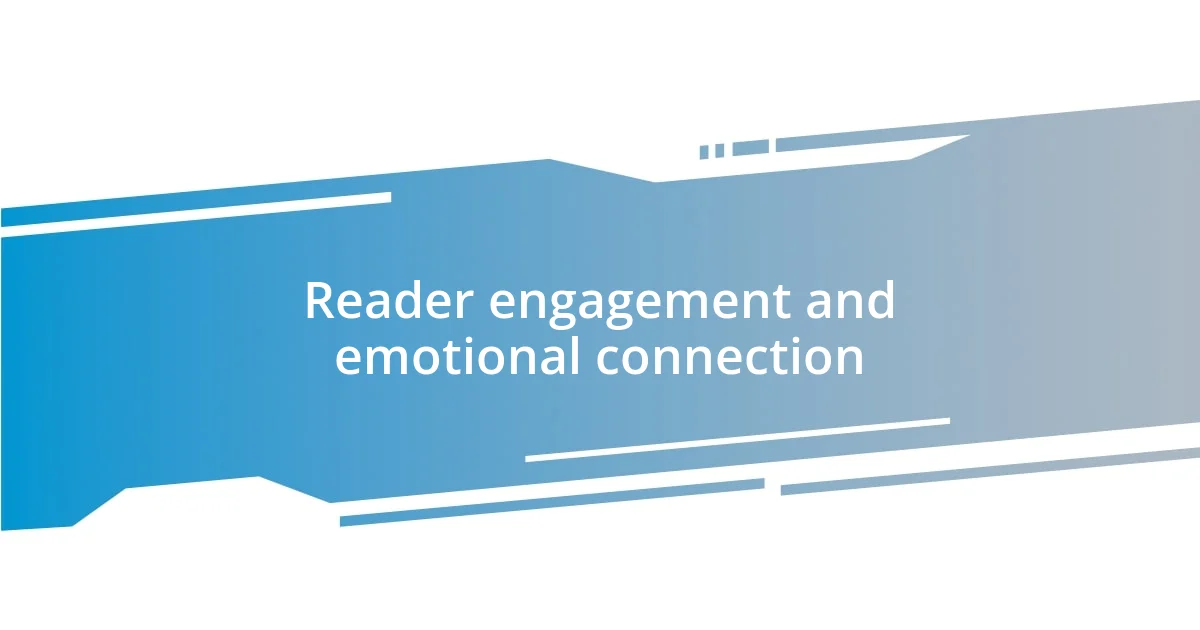
Reader engagement and emotional connection
Epistolary novels have an incredible way of pulling readers deep into the characters’ emotional landscapes. I recall diving into “The Fault in Our Stars” and being captivated by Hazel’s letters. They didn’t just tell a story; they bared her soul. I could feel her hopes, fears, and yearnings radiate through the pages. Have you ever felt so connected to a character that their struggles felt like your own? That’s the magic of well-crafted correspondence; it hooks you into an intimate dialogue that resonates long after the book is closed.
When characters lay bare their thoughts and feelings through letters, it fosters a unique bond between the reader and the narrative. In “We Need to Talk About Kevin,” the raw honesty in Eva’s messages sparks a whirlwind of emotions in me. I found myself reflecting on parenthood and the weight of choices—how do we process such profound themes through another’s lens? There’s something incredibly powerful about seeing life through someone else’s eyes, which can evoke empathy and understanding in ways other formats simply can’t.
The immediacy of letters also heightens the emotional stakes. I remember pages from “Letters to a Young Poet” that challenged me to confront my own creative fears. The way Rainer Maria Rilke articulated the complexities of doubt and aspiration really hit home. Can writing about one’s struggles make it feel less isolating? This interplay of vulnerability and connection is what keeps me engaged, prompting readers to reflect on their experiences alongside the characters. It’s a delightful blend of storytelling and emotional catharsis.
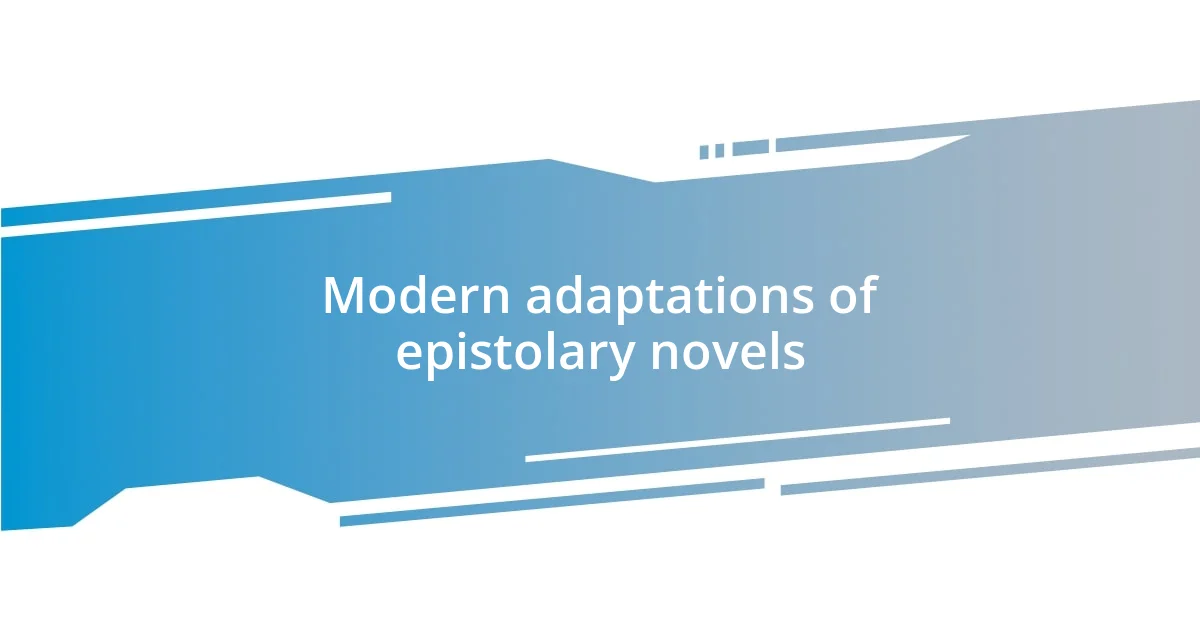
Modern adaptations of epistolary novels
Adapting epistolary novels for modern audiences has opened a fascinating door to innovation. One striking example is the use of social media as a platform for storytelling. I recently enjoyed a contemporary adaptation of “Pride and Prejudice,” presented through Twitter exchanges between characters. The brevity and immediacy of tweets created a lively dynamic that felt so relevant. Have you ever considered how modern communication tools can transform classic narratives? It really highlights how love stories can transcend time.
Furthermore, graphic novels have taken the epistolary format to exciting new heights. For instance, “Fun Home” employs illustrated letters, allowing readers to visually engage with the characters’ emotions. I felt a profound connection as the images and text intertwined, pulling me even deeper into Alison Bechdel’s exploration of her life. It made me reflect on how powerful visual storytelling can be—doesn’t it elevate the emotional experience? The combination of art and correspondence creates a vivid tapestry of feelings that resonates long after the last page is turned.
Finally, the rise of digital platforms has birthed immersive experiences that incorporate multimedia elements. “Dear Evan Hansen,” for example, expands on the concept of epistolary communication through emails, videos, and social media posts. As I followed Evan’s journey, I found myself completely enveloped in the urgency of his digital exchanges. Isn’t it intriguing how modern adaptations can influence our understanding of identity and connection? I believe these fresh interpretations breathe new life into epistolary novels, ensuring they remain deeply engaging and relevant in our constantly evolving world.

Insights from popular epistolary works
The beauty of epistolary novels often reveals itself in their exploration of personal narratives through letters. A prime example is “The Color Purple,” where Celie’s letters are more than mere words; they are her outlet for survival and self-discovery. Each letter felt like a piece of her heart unraveling, and as I read, I found myself wondering how often we express our deepest feelings in writing. It made me reflect on the letters I’ve written, often pouring out thoughts I’d struggle to share face-to-face. Don’t you think there’s something uniquely freeing about writing things down?
Another profound insight comes from “84, Charing Cross Road,” which showcases the power of correspondence to bridge distances and foster connection. Helen Hanff’s letters to a London bookseller opened a world of literary camaraderie for me. I could practically hear her voice in each line, the warmth between her and Frank characterized by both humor and sincerity. It prompts me to ask: how do written letters create bonds that sometimes feel deeper than spoken words? The intimacy found in these exchanges is profound and can spark joy, longing, and understanding that lingers long after the final letter is read.
Moreover, reading “Fahrenheit 451” is a stark reminder of the dangers of losing the written word. The letters exchanged in the book serve as a symbol of rebellion and the quest for knowledge. As I dived into Montag’s struggles with censorship, I couldn’t help but feel a nagging doubt about our own relationship with communication today. Are we becoming too reliant on fleeting digital messages to convey our thoughts? This reflection deepens my understanding of the epistolary format, showing that its power lies not only in what is written but also in the connections forged and the ideas shared.












